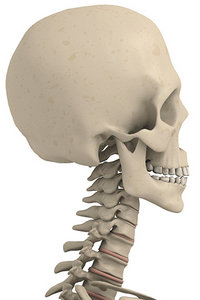The temporo-mandibular joint is an interesting and dynamic articulation that can cause a lot of problems. Hoppenfeld1 notes that the TMJ is the most used joint in the body, and it opens and closes 1,500 to 2,000 times a day during its various motions of chewing, talking, swallowing, etc.
In modern society, the number of people who clench their jaw or grind their teeth must also be considered as stress factors on the TMJ. It should be noted that pain is not often referred to the TMJ, but the joint often refers to other areas – often to the head and neck. The malfunctioning TMJ is one of the classic examples of a peripheral irritant causing a variety of pain patterns by firing noxious nerve impulses into the nervous system – and has been called "The Great Impostor."2
In an ideal arc of motion, the opening and closing of the TMJ is smooth and unbroken – but there are actually two separate motions that take place – the joint hinges within the glenoid fossa and glides forward to the eminentia. The upper portion of the joint is used for hinge motion, and the lower is used for glide. The dual heads of the external pterygoid muscles act asynchronously, with one head pulling the meniscus forward as the second opens the joint.
When evaluating a patient, I will often stand at the head and look down across the face – lining up the nose and chin for symmetry – then have the patient slowly open and close the jaw. Any deviation side to side is an indication of joint dysfunction. Nimmo3 references that clicking is due to stretched ligaments, and this should resolve with treatment and healing. Normally a person should be able to open wide enough so that they can insert three fingers between the incisors.
 Placing the index fingers into the auditory canal will allow you to feel the motion of the joint. Passive motion can be tested by placing the fingers on the lower incisors and pushing the mouth open (gently) as far as reasonable. Limitations noted may be due to dysfunction, RA, congenital anomalies, ankylosis, TMJ osteoarthritis, or muscle spasm.
Placing the index fingers into the auditory canal will allow you to feel the motion of the joint. Passive motion can be tested by placing the fingers on the lower incisors and pushing the mouth open (gently) as far as reasonable. Limitations noted may be due to dysfunction, RA, congenital anomalies, ankylosis, TMJ osteoarthritis, or muscle spasm.
Reflex testing of the TMJ involves the masseter and temporalis muscles. Place a finger on the chin with the mouth open and gently tap with a reflex hammer – the mouth should close. An absent or diminished reflex suggests pathology of the fifth cranial nerve. Hyper-reflex response may be due to an upper motor neuron lesion. Also to be noted is Chvostek's test – tapping the area of the parotid gland overlying the masseter muscle. The facial muscles will contract in a twitch if blood calcium is low.
Acupuncture can provide great relief. Local points to be considered should include ST7, SJ, SI19, and CB2.3 Distal points should include LU7 and LI4. I have also found ST45 to be a magical point for jaw problems. If it is within your scope, there are a number of good manual treatment options including manual impulse, Activator, and even Thompson Drop.
I typically prefer to follow the Nimmo protocols to address the regional muscles. Appropriate treatment of the TMJ must include the temporalis, pterygoids, masseters, and tensor veli palatini. There is not sufficient space to go into full discussion of the protocols for each muscle in the scope of this article, but the references below give excellent explanations and examples of treatment. Gentle pressure – 3 to 5 lbs. – for a few seconds is often enough. Often trigger points will be unilateral, but always check both sides. It must also be recognized that the TMJ is in very close proximity to the upper cervical complex and inner ear – these must also be fully evaluated in the symptomatic patient.
The TMJ can quickly become a very complicated joint with many factors to consider.
Not all TMJs are created equal. Kids wearing braces, auto accident/whiplash, and good old fashioned tension can all contribute. Sometimes TMJ problems are entirely secondary to other issues or treatments, such as pressure on the jaw from halter traction for a neck injury. Take the time to slowly evaluate and determine what the best course of care will be. As always, document the presenting complaints, exam findings, diagnoses, care plan, and response to care. Your patient will thank you for your quality care.
References
- Hoppenfeld, S. (1976) Physical Examination of the Spine and Extremities San Mateo, CA: Appleton & Lange.
- Nimmo, R and Laws, S. (2001) The Collected Writings of Nimmo and Vannerson Schneider, Cohen and Laws.
- Amaro, JA Personal Experience Points CareFree, AZ: International Academy of Medical Acupuncture See also: Travell, JG (1983) Myofascial Pain and Dysfunction Philadelphia, PA: Williams and Wilkins
Click here for more information about Douglas R. Briggs, DC, Dipl. Ac. (IAMA), DAAPM, EMT.




